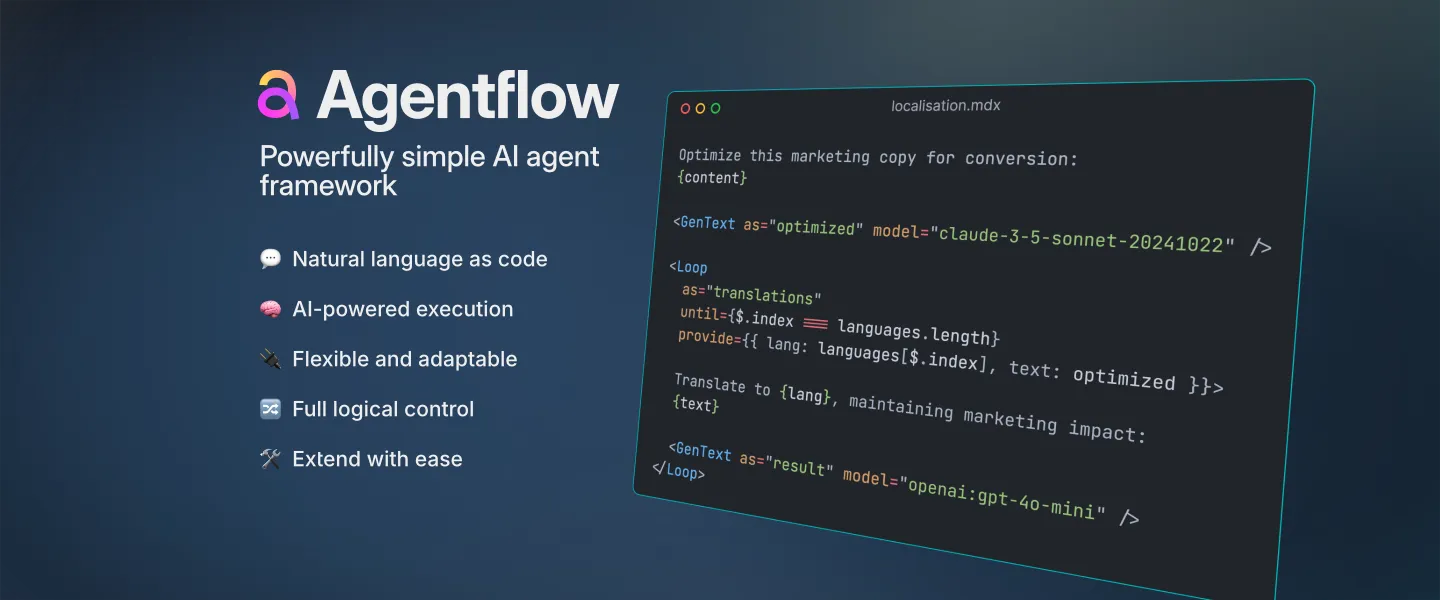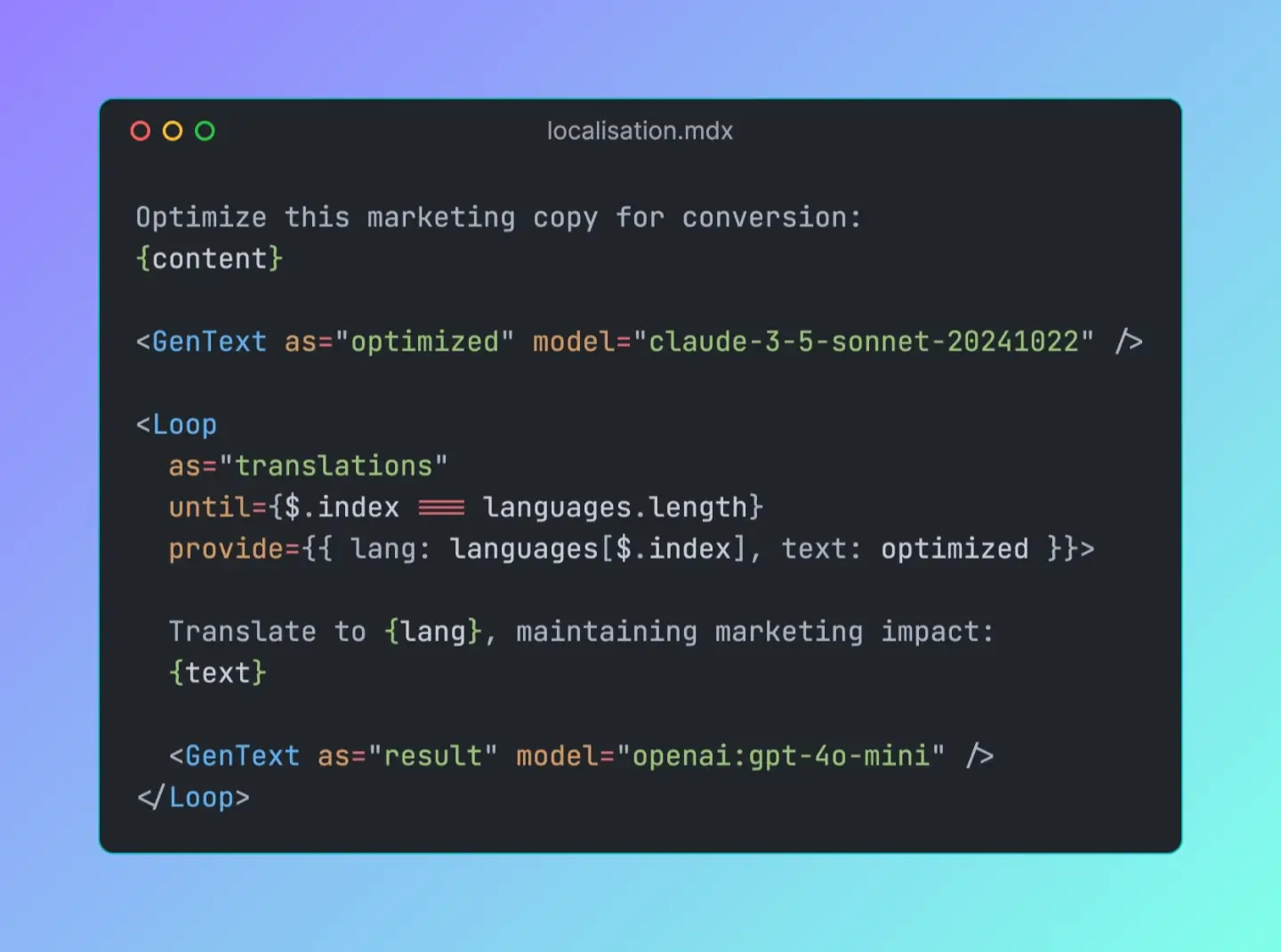Announcing Agentflow

I’m very pleased to announce the launch of Agentflow - a powerfully simple AI agent framework.
Agentflow enables developers to create AI workflows that read like documentation but execute like code. By combining natural language with minimal markup, you can compose complex agent behaviours using plain English as your main programming language.
The framework provides all the structure and control you’d expect from traditional programming but is expressed in an intuitive Markdown-based format that puts readability first.
Not another one. Why?

The path to Agentflow began with a simple frustration. I am not a Python developer. Frameworks like CrewAI and LangChain dominate the AI agent space, but I found myself wanting similar tooling using languages I was more comfortable with and that better suited my development style.
I’ve also noticed a trend that many agent frameworks are quite complex and enterprise-focused. I didn’t want to set up servers and infrastructure; I just wanted something lightweight and easy that I could hack around with on my own computer.
Not too many moons ago I shared my work on Shifts, an Elixir-based agent framework inspired by CrewAI. I definitely learnt some lessons building Shifts, but it didn’t feel like I’d nailed it. So, I put it down to think about the problem again.
There’s an old tweet from Andrej Karparthy that simply says, “The hottest new programming language is English”. I love that idea, and it got me thinking… What if we could create a framework that embraces that idea, and puts the human intent front and centre? Rather than bringing prompts into code, could we somehow make the prompts the code? This thinking led directly to what would become Agentflow.
What makes Agentflow different?
From the start, Agentflow embraces natural language as its primary input. Instead of constructing agents with code that contains prompts, with Agentflow you write prompts that contain minimal code. This makes the composition of agents simpler, but more importantly, it puts human intent front and centre of the development process.
Workflows are written using a variation of Markdown similar to MDX (in fact, it uses the MDX parser internally). The result is a format that is as readable as plain text and with enough structure to implement loops, conditional branching and call actions inside the workflow.

Staying true to this text-first philosophy, Agentflow operates entirely through a command-line interface - no GUI required. It’s lightweight and easy to install, with no infrastructure or cloud requirements. You can get everything up and running on your machine in under a minute.
Under the hood, Agentflow is powered by Vercel’s excellent AI SDK. This means baked-in support for any AI provider supported by the SDK (that’s pretty much all of them), and agents can use any third-party tools compatible with AI SDK. The result is a framework that is as capable as it is approachable, whether building simple automations or sophisticated AI-powered workflows.
Looking ahead
Agentflow is still in its early stages and there’s a lot of work ahead. Like any new software, there will be bugs to fix, rough edges to smooth out, and for now the design and APIs are all subject to change as I learn how people use Agentflow out in the wild.
And that’s exactly why I’m releasing Agentflow now. I want to see how people use it, learn from their experiences, and understand what they need. All feedback is valuable at this stage, whether it’s bug reports or feature requests. While there are clear areas for improvement, such as expanding the collection of first-party tools, or thinking carefully about security when users start sharing workflows and actions, the exact direction will be influenced by users’ needs and experiences.
My hope for Agentflow is simple: I want to make it easier for anyone to start experimenting with and building AI agents. Whether you’re an experienced developer or a weekend-only hacker and tinkerer, Agentflow’s JavaScript foundations and natural language programming should feel intuitive and accessible. I’m excited to see what people build with it, how they extend it, and where they take it.
Get building
Ready to try Agentflow? Head over to the Agentflow docs - the getting started guide will walk you through installation and creating and running your first workflow.
For those interested in reporting bugs, getting involved, or just reading the source code, head over to the Agentflow repository on GitHub.
I’m looking forward to seeing what you build with it!